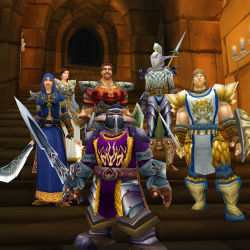
Hugely popular online virtual worlds such as World of Warcraft and Second Life offer social scientists unprecedented views of gamers’ behavior, and may be used as a model for their decisions in the real world.
If they could only get their hands on the raw data. Until recently, social scientists could only study virtual worlds through surveys, which have inherent sampling issues. Then, Sony opened up for scientific investigation its data for the EverQuest 2 online virtual world to a team of social scientists, economists, anthropologists and computer scientists.
"Be careful for what you ask for," says Dmitri Williams, assistant professor at the University of Southern California. "These are big, ugly, nasty, complex data logs but they literally do chart everything."
"This particular game world has been going on for four years, so we have potential access to four-and-a-half years of behavior for 400,000 people over that time and everything they did at every second over that entire time period — every interaction, every transaction, every action, anything that changed the underlying database state of this virtual world is recorded," says Williams. "So our task has been to make sense of these recordings and to use them to test social scientific theories in a rigorous way."
It has been the job of Jaideep Srivastava, professor at the University of Minnesota, to mine the "big, ugly, nasty, complex data logs" and find where precious ores might lie buried. His team began their project by analyzing the surface layers, just three terabytes of data. The entire reservoir that they would eventually like to excavate is 56 terabytes.
A Matter of Trust
One of the key goals of the EverQuest 2 project has been to create metrics for the social scientists. For instance, gamers must work in groups to accomplish large tasks or to defeat huge monsters. Quantifying the level of trust each player has for another is something social scientists would like to understand.
Traditionally, trust has been gauged through surveys, but it may be possible to look at click stream data to discern a quantifiable level of trust by looking at how many times players have played with each other, how many times they’ve been victorious, and other key facts.
Understanding these levels of trust could have a big impact for the gaming industry, which relies on happy users regularly paying monthly subscription fees to survive (EverQuest 2 and World of Warcraft each cost about $15 per month). By looking at the game world, social and computer scientists can accurately model the "churn rate," basically the likelihood that established users will leave and whether they will take other players with them.
By knowing what sort of game development factors are influencing the churn rate, developers and business people might be able to change the game to guarantee higher rates of enjoyment, higher player retention rates, and as a result, higher profitability.
"There’s an opportunity to observe behavior down to the level of every click," said Srivastava, "and we hope to understand behavior at a much finer granularity and with a higher degree of accuracy."
Graeme Stemp-Morlock is a freelance science writer based in Waterloo, Ontario.



Join the Discussion (0)
Become a Member or Sign In to Post a Comment